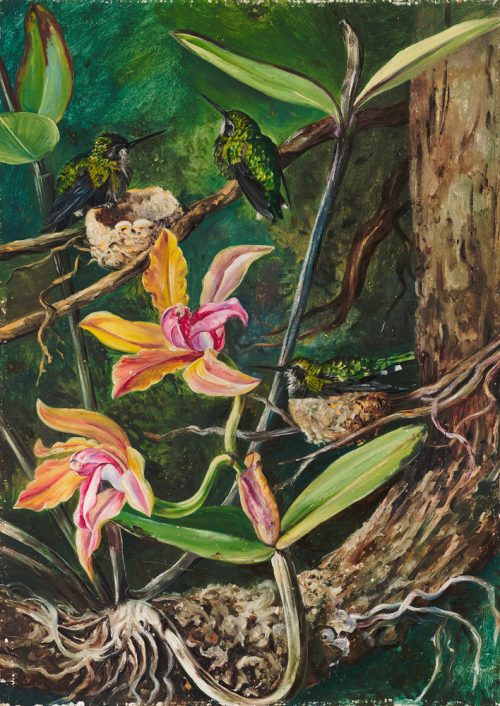
BY JUDY CARMACK BROSS
The Remarkable Mrs. North, a vibrant documentary of an artist who broke with Victorian tradition in the 1870s and ‘80s to travel alone through dangerous wildernesses across five continents to paint lush flora and fauna, will air on the Smithsonian Channel March 8, thanks to the sponsorship of Chicagoans Pamela and Tom Sheffield. They recently previewed the documentary, first shown on the BBC, for members of the Old Masters Society and the Kew Foundation America at the Art Institute of Chicago.
Chicagoan David McNeel introduced the Sheffields to former British media executive Jack Andrews, now Kew’s chief volunteer guide, who first escorted them through the North Gallery at Kew Gardens in 2009. Mesmerized by her 833 paintings, which fill the gallery, the Sheffields felt compelled to tell North’s story. Tom explains their wonder:
“She was not only a Victorian pioneer but also the UK’s most prolific painter. She undertook such risky travels to preserve the beauty of nature—such an intrepid and independent spirit. The Royal Gardens at Kew definitely are a powerhouse of plants, and her gallery features 900 species that she painted in 17 countries.”
Emilia Fox, star of TV productions of Rebecca and Pride and Prejudice, as well as the highly popular BBC crime drama Silent Witness, gamely slogged through forests in Borneo in search of rare carnivorous pitcher plants discovered by and named for the artist. As the documentary’s narrator, Fox scales slopes navigated by North, speculating how the artist accomplished all she did while wearing the long skirts of the day and lugging her paint box.
In the documentary she relates how Charles Darwin had tremendous respect for North, the daughter of his old friend Frederick North, a wealthy British landowner and Member of Parliament. Marianne had no formal botanical training but undertook many dangerous adventures, fought off typhoid and rheumatic fever, and other life-threatening diseases to paint the beauty that she saw.
Quite simply, Fox says:
“Her oil paintings blur the lines between science and art and bring to life Darwin’s On the Origin of Species. Darwin urged her to visit New Zealand and Australia, and we read of those two having tea together.
“It was not like she was photographing the flowers to paint when she returned to England—she was painting them on the spot. She was climbing over rocks and under waterfalls, all with her paints in hand. They are often more than flowers but landscapes with animals in them in as well. She was quite a maverick.”
The paintings lining the walls of the North gallery, built in 1882, tell the story of her extraordinary travels. Her gallery at Kew is the only permanent exhibition featuring a singular female artist in Britain.
Traveling with her father until he died in 1869, North used letters of introduction from friends after his death to gain entrée into countries never explored by a woman alone. In her travels to the United States, she painted California redwoods, expressing her concern about their increasing destruction at the time.
Tom Sheffield relates how it all began:
“We were in London for Wimbledon in 2009 and followed our friend David McNeel’s advice to visit Kew. Pam and I were so impressed that, over lunch at Ma Cuisine in Kew with our guide Jack Andrews, the idea of a documentary got started. I had never worked on a film, and suddenly we were launching a documentary—not an easy task it proved to be.
“We were delighted to work with Sir Peter Crane, former Director of the Royal Botanic Gardens at Kew who had worked previously at the Field Museum. The real credit goes to Jack who persevered with the project. At many times it was an uphill battle. Several of our scenes are shot at Kew, and thanks to Jack, we had free run there.”
Laura de Frise, President of the Old Masters Society, welcomed the opportunity for a private screening of the documentary:
“Marianne North’s spirit, adventurous travels, and exquisite paintings came to life right before our eyes during the hour-long documentary. Joining us from London were Alessio di Capua, Executive Director of Kew Foundation America, and Alison Purvis, Director of Development Kew Foundation. All who attended were delighted by the movie and expressed how grateful they were to Tom and Pam for introducing us to Miss North and Kew.
“The Old Masters Society, whose mission is to support the Department of European Painting and Sculpture at the Art Institute, was thrilled to welcome and share such a special evening with many new friends. I certainly know a highlight of my next trip to London will be a visit to the Marianne North Gallery at the Royal Botanic Gardens at Kew with my architect husband, Steve Rugo.”
Tom Sheffield says that Marianne North always found a way to get her way:
“After she had donated her works to Kew in 1879, North asked Joseph Hooker, the director at the time, if she could serve visitors a simple cup of coffee or tea. He was adamant that they didn’t do things like that at Kew. She subsequently painted coffee and tea plants around the doors so that visitors would know that she had been thinking of them.
“Marianne North was at all times intrepid, a visionary and a person of passionate determination.”
For more information about Kew, email kfa@kew.org.












